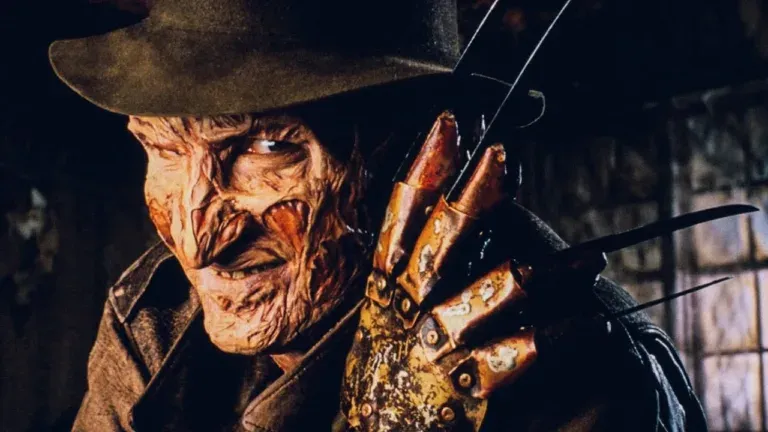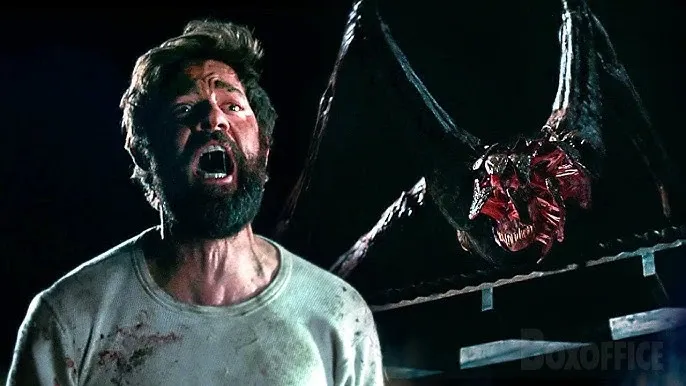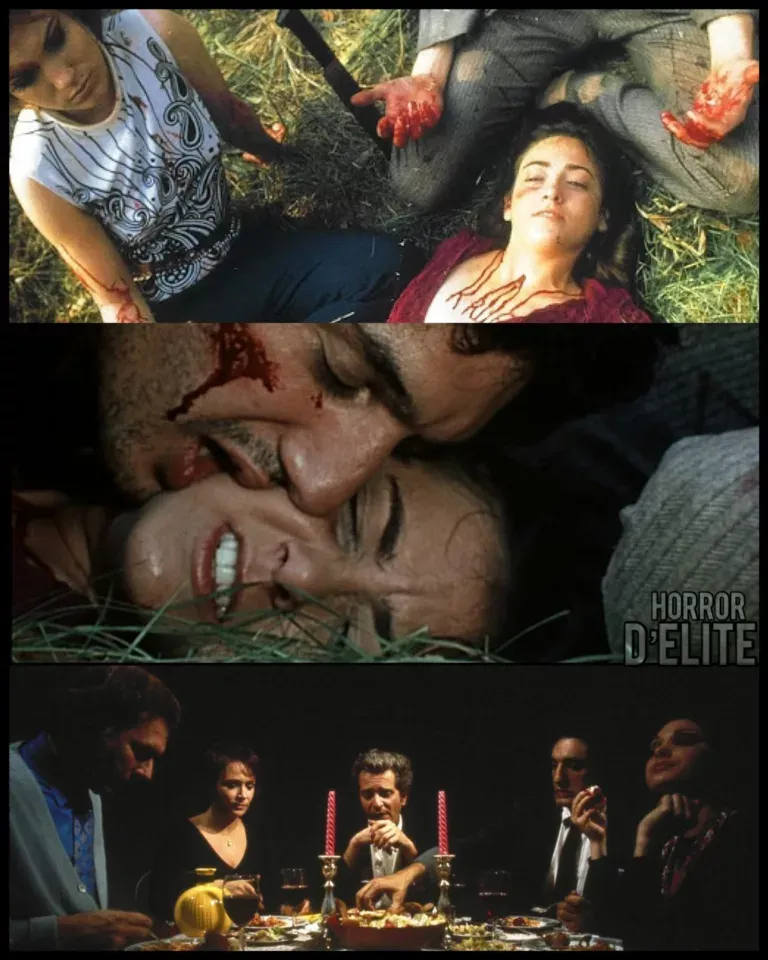Hellraiser
Hellraiser (Clive Barker, 1987)
“Hellraiser” is a 1987 horror film written and directed by Clive Barker, based on his 1986 novella “The Hellbound Heart”. The film is known for introducing the character Pinhead, an iconic figure leading a group of demons known as the “Cenobites”, who belong to the universe of the “Hellraiser” film series.
The story revolves around an ancient puzzle box called the “Lament Configuration”, or “Lemarchand’s box,” which, when solved, opens a gateway to a demonic dimension called “Hell”. The protagonist, Frank Cotton, solves the puzzle, opening a connection with the Cenobites, sadomasochistic creatures from Hell. Frank is tortured by the Cenobites and reduced to a state of non-life. Later, his sister-in-law Julia, who is secretly in love with him, discovers the ritual to revive Frank by absorbing human blood.
When Larry, Julia’s husband, moves into the family house with his daughter Kirsty, they accidentally discover Frank’s resurrected body. Kirsty, suspecting something dark, begins to investigate and encounters the puzzle box. She discovers the dark connection between the box and the Cenobites and tries to escape their clutches as they seek to return Frank to Hell.
The film is known for its graphic and disturbing imagery, as well as its depiction of sexual horror and the inner darkness of humanity. “Hellraiser” spawned a series of sequels, spin-offs, and adaptations in other media, but the first film is still considered a classic in the horror genre for its originality and visual impact.
Fun Facts and Insights
Born in Liverpool in 1952, Clive Barker has been involved in various forms of art since childhood: literature, painting, theater, film, and comics. He studied at the Liverpool College of Art and moved to London in the early ’70s, where he worked as an illustrator for pornographic novels before becoming a playwright of bizarre theatrical productions, featuring famous comic characters mixed with demons in grand guignol settings.
In 1983, he began writing horror novels and stories that were well received by the public and critics. Among his readers was an enthusiastic Stephen King, who said, “I have seen the future of horror, and his name is Clive Barker.”
After the famous “Books of Blood” series, Barker turned to directing, deciding to adapt his novella “The Hellbound Heart” into the film “Hellraiser” (1987).
Unfortunately, his excellent debut did not have a follow-up, as apart from writing the scripts for the subsequent chapters and the notorious flop of “Cabal” (dubbed the Star Wars of horror for its massive special effects), some films based on his writings, like “Underworld” and “Rawhead Rex”, were directed by the incompetent George Pavlou.
Barker was also friends with Lucio Fulci, to the extent that the Italian director closed “Voices from Beyond” with a personal dedication.
Other Fun Facts
Clive Barker dixit:
“In Hellraiser, the cliché of disintegration, of physical dissolution, which is a hallmark of horror cinema, is exactly reversed. Here, bodies reassemble, layer by layer.”
Clive Barker dixit 2:
“Lucio Fulci is a genius. The best. His ‘The Beyond’ is one of my cult films.”
During a party held to celebrate the end of filming, Doug Bradley (Pinhead) found himself ignored by all other crew and cast members. Reflecting on the camaraderie experienced during filming, he was deeply dismayed and perplexed. Only much later did he realize that apart from Barker and the special effects crew, no one had ever seen him without makeup, hence no one recognized him at the party.
The film’s title was originally supposed to be the same as Barker’s novella, “The Hellbound Heart” (translated as “Scholars from Hell” in Italy). The producers felt that title gave the strong impression of a romance and asked Barker to change it. Barker countered with “Sadomasochists from Beyond the Grave,” which was rejected for its explicit sexual content. Exasperated, he proposed to a sixty-year-old member of the production team, “What a Woman Will Do for a Good Fuck”.
Doug Bradley’s character was initially called Priest in early drafts of the script, later becoming Lead Cenobite in the final script. Pinhead was just a nickname given by the crew to identify the character. It prevailed and was used in subsequent sequels. Barker hated the name, finding it derogatory and not in line with the Cenobites’ ecclesiastical austerity; in the 2011 “Hellraiser” comic produced by BOOM!, he renamed him Priest, announcing that he would reveal his true Cenobite name in a future work. Similarly, the female Cenobite was called Deep Throat on set, due to the character’s dominant sexual aspect; although this moniker was also nearly adopted, she remained the Female Cenobite in the sequels.
Many viewers have criticized the poor special effects at the end of the film. Barker explained that due to the very tight budget, there was no money left for professional special effects artists, so he and an unidentified “Greek guy” animated these scenes by hand over a weekend. Barker said he was satisfied with the final result, considering the amount of alcohol consumed by the two during the work.
Clare Higgins hated horror films. When she saw “Hellraiser” at the premiere, she left the theater after 10 minutes, terrified. She has never managed to watch the entire film.
Doug Bradley was originally asked to choose between the role of one of the two movers carrying the mattress and the leader of the Cenobites. Initially, he preferred the minor role because he found it important to be recognized by the audience.
The Chatterer and Butterball had dialogue parts in the original script. When the makeup made it impossible for the actors to speak coherently, their lines were given to the female Cenobite and especially to Pinhead, which helped solidify his reputation as the franchise’s trademark.
Andrew Robinson convinced Clive Barker to replace “Fuck you!” with the line that ended up in the final cut, “Jesus wept!” (apparently absent in the Italian version; the exclamation, which literally means “Jesus wept,” is blasphemous and roughly equivalent to a famous Italian curse).
The idea of a cube used as a portal to Hell is based on an urban legend about the existence of a human-sized cubic structure of unspecified location, with mirrored inner faces creating six infinite reflections. According to the legend, anyone who locks themselves inside will experience phenomena so disturbing they will permanently damage their mental balance.
To economize on the budget, the studio intended to hire stuntmen to play the Cenobites. Barker insisted on having professional actors play them, arguing that even if the characters are mute and heavily made-up, their studied body language would give the ensemble a strong personality.
The budget was one million dollars. The film grossed about 20 million.







